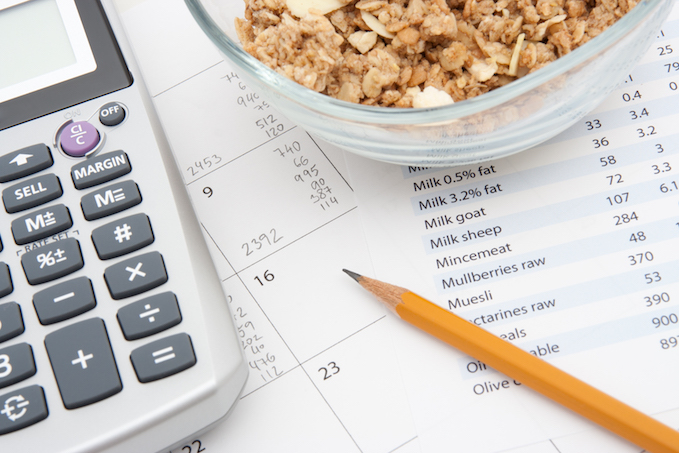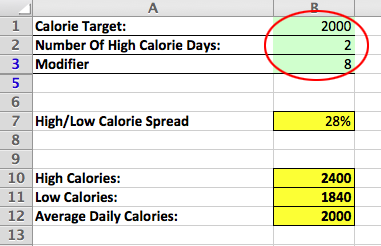How To Optimize Your Diet With Calorie Cycling

Many diets will have you eating roughly the same number of calories each day.
However, there are also a several notable diets that will have you eating considerably more or less depending on which day of the week it is.
This practice is commonly known as ‘calorie cycling’, and like intermittent fasting, it is a concept that has been gaining a lot of popularity in the last few years.
The 5:2 Diet is a good example of this, as is The Military Diet that we recently wrote about.
Unfortunately, like many concepts in fitness and nutrition, it is often way over sold – with people claiming that it allows you to binge eat while still losing fat.
Or that it is somehow ‘the secret’ to putting on pounds of muscle really quickly…
Of course, none of this is true.
Just like intermittent fasting, calorie cycling is a tool that you can use to modify your diet to better fit you – but there is nothing magical about it.
To help clarify things, in this article we’ll be going over whether you should incorporate calorie cycling into your diet – and, if so, how exactly you should go about doing it.
Is Calorie Cycling Right For You?
Just as with intermittent fasting, calorie cycling isn’t for everyone.
For many people, we would recommend sticking with a more basic approach to counting your calories and macros until you’re more comfortable with the whole thing, or exploring the other dieting approaches available to you.
This is undeniably more straightforward, and will still get you great results if you stick to your plan.
That being said, there are 2 situations where it might make sense for you to incorporate calorie cycling into your diet.
1) You are looking to really fine-tune and optimize your diet.
2) You want to have some room to eat more calories on certain days (weekends), while still making progress with your diet.
Let’s take a brief look at both of these approaches, so that you can get a sense of how each one might be applicable.
Approach #1: Higher Calories On Workout Days
This is the calorie cycling approach that is most commonly recommended.
Basically, you would consume a higher number of calories on workout days, and a lower number of calories on your rest days.
The rationale here is that your body’s energy requirements are arguably higher on workout days, due to the greater energy expenditure from your training.
In turn, without the added exercise, your body’s energy requirements are lower on non-workout days.
Advocates of this approach claim that this can help you build muscle and lose fat more efficiently.
On your workout days, you are effectively in a caloric surplus, allowing you to progress more effectively with your workouts.
On your non-workout days, you are in a caloric deficit, helping to maximize fat loss.
However, in practice there is limited evidence to support this claim.
Anecdotally some people swear by it, but that’s about as much as you can say definitively at this point.
In our opinion, it’s not going to make or break your progress – and what is going to matter a lot more is whether you’re consistently hitting your calorie/macro targets and working out properly – but it is still worth a try if you have a generally good handle on your diet.
Approach #2: Higher Calories On The Weekends
Now this strategy isn’t so much about maximizing your progress as much as it is about making your life more enjoyable!
From our experience, many people find it hardest to control their caloric intake on the weekends.
During the week, things tend to be more routine for many of us, making it a lot easier to stick to a more defined eating pattern – whereas the weekends are the time where we want to kick back, relax, and enjoy ourselves.
With this approach, by keeping your calories lower during the week, you’ll essentially be ‘saving up’ more calories that you can eat during the weekends – all while still maintaining the same daily average caloric intake.
And while arguably this is less optimal, from a progress standpoint, than the other calorie cycling approach – it is a lot more fun and can help considerably with sticking to your diet, and can help with overall dietary compliance.
Moreover, it can help buffer any over-eating that tends to happen on the weekends, acting as an insurance policy if you tend to overdo it a bit on Saturday or Sunday.
How To Implement Calorie Cycling
We’ve made it as easy as possible for you to integrate calorie cycling into your flexible dieting approach.
When calorie cycling, the biggest thing that you’ll need to figure out is the number of calories that you’ll be eating on your ‘high’ calorie days, and the number you’ll be eating on your ‘low’ calorie days.
To do this, just use our calorie cycling calculator, which you can download here:
Calorie Cycling Calculator (For Use In Microsoft Excel)
Using The Calculator To Adjust Your Calorie Targets
Once you’ve downloaded the calculator, open it up in Microsoft Excel.
You’ll see 3 green colored fields at the top of the calculator (as pictured below).

Now here are the 3 steps you need to take to figure out your ‘high’ and ‘low’ calorie targets.
Step 1: In the green field next to ‘Calorie Target’, enter the calorie target that you are trying to hit each day to either gain or lose weight.
Step 2: In the green field next to ‘Number Of High Calorie Days’, enter the number of days that you’ll be eating at a higher calorie level.
If you are following approach #1, this will just be the number of weight training days in your current workout plan.
If you are following approach #2, this will typically be ‘2’, for both weekend days where you’ll be eating higher calories.
Step 3: Finally, adjust the number in the green field next to ‘Modifier’. This will adjust the spread between high calorie days and low calorie days.
The higher the number you enter here, the greater the difference between the high & low calorie days.
The lower the number you enter here, the smaller the difference between the high & low calorie days.
We recommend aiming for a spread between 20% and 30%, but the specific number is up to you and how you’d like to partition your calories.
In this example, you’ll see that entering the number ‘8’ gives us a 28% spread (as illustrated below).

This means that on the lower calorie days you’ll be eating 28% less than on the higher calorie days.
In this example, the regular daily calorie target is 2000 calories.
With this 28% difference, you would be eating 1840 calories on weekdays, slightly lower than your regular 2000 calorie daily target.
However, this would allow you to eat 2400 calories on both weekend days, which is 400 calories more than the daily 2000 target, while still maintaining the same calorie average for the week.
Adjusting Your Macro Targets
Now that you have the 2 different calorie targets that you’ll be following, you need to adjust your macro targets as well.
Thankfully, this is very easy to do.
To keep things simple, we suggest keeping your protein target the same, regardless of whether it is a high or low calorie day.
So if your protein target is 180-200 grams per day, you’ll be trying to hit that on both your high and low calorie days.
As for your fat target, we suggest keeping it at the same percentage of your daily caloric intake, adjusting the number of grams for both the high and low calorie days.
Finally, your carb target will just be the remaining number of calories you have for the day, after you’ve met both your protein and fat targets.
So this means that on your lower calorie days, you’ll be consuming fewer carbohydrates, whereas on your higher calorie days you’ll be consuming more carbohydrates – so as to meet your different calorie goals.
The Bottom Line On Calorie Cycling
Although calorie cycling can be used effectively whether you’re cutting, bulking, or reverse dieting, we find that from a practical standpoint it is most useful when you’re eating a lower number of overall calories.
In this sense, many people find it more useful while ‘cutting’ rather than while ‘bulking’.
When you’re cutting, you have fewer overall calories to work with, and therefore there is a bigger potential physiological benefit to following approach #1 (due to the effective caloric surplus on workout days), and a greater psychological benefit to following approach #2 (not feeling as much like you’re dieting on the weekends).
On the other hand, when you’re eating more calories – like when bulking – there isn’t as much of a physiological benefit to having higher calories on workout days (since they are high anyway), and there isn’t as much of a psychological benefit to having even higher calories on the weekends (again, since they are high anyway).
For this reason, you’ll find that as you increase your calories – like if you decide to reverse diet after cutting – you’ll often want to gradually reduce the spread until you reach a high enough calorie level where you stop calorie cycling altogether.
Obviously, this part is completely up to you, but this is a’best practice that we’ve found to be useful when working with clients.